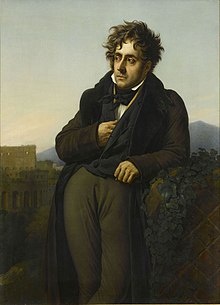Mémoires d'Outre-Tombe
This article needs additional citations for verification. (September 2009) |
| Author | François-René de Chateaubriand |
|---|---|
| Original title | Mémoires d'Outre-Tombe |
| Language | French |
| Published | 1849 (Vol. 1) 1850 (Vol. 2) |
| Publication place | France |
| Media type | |
| OCLC | 829269852 |
| LC Class | DC255.C4 A4 1849 |
Mémoires d'Outre-Tombe (Template:Lang-en) is the memoir of François-René de Chateaubriand (1768–1848), collected and published posthumously in two volumes in 1849 and 1850, respectively. Chateaubriand was a writer, politician, diplomat, and historian who is regarded as the founder of French Romanticism.
Although the work shares characteristics with earlier French "memoirs" (like the Memoirs of Saint-Simon), the Mémoires d'Outre-Tombe are also inspired by the Confessions of Jean-Jacques Rousseau: in addition to providing a record of political and historical events, Chateaubriand includes details of his private life and his personal aspirations.
The work abounds in instances of the poetic prose at which Chateaubriand excelled. On the other hand, the melancholy of the autobiography helped establish Chateaubriand as the idol of the young French Romantics; a young Victor Hugo wrote: "I will be Chateaubriand or nothing."
Genesis of the work

It was while in Rome at the close of 1803 that Chateaubriand decided to write his memoirs; however, he did not begin writing them until 1809, and even then demands from other projects slowed his progress. In 1817 he returned to the memoirs. The first manuscript, probably written while he was serving as ambassador to London, did not reach completion until 1826. At this point, he intended to entitle the book Memories of My Life.
In 1830, however, Chateaubriand decided to change the scope of the work, revising the title to Mémoires d'Outre-Tombe, making a thorough revision of the original text, and writing several new volumes. He divided his life before 1830 into three periods: soldier and traveler, novelist, and statesman. The project had by now become more ambitious; indeed, he tried to reproduce not only his personal exploits, but the epic historical and political events of the era.
Publication
After fragmented public readings of his work in salons, in 1836 Chateaubriand yielded the rights to his work to a society that published it until his death, paying him accordingly. Having obtained this economic stability, he completed the work with a fourth set of volumes. In 1841 he wrote an ample conclusion and kept revising parts of the work until 1847, as evidenced by the revision dates in the manuscript.
Chateaubriand originally intended for the work to be published at least fifty years after his death, but his financial troubles forced him, in his words, "to mortgage [his] tomb".
English translations
There have been a number of English translations. British author Anthony Kline published a complete translation in 2005 that is freely available for non-commercial use.[1][2] An abridged translation by Robert Baldick was first published by Alfred A. Knopf in 1961, and later, in paperback, by Penguin books in 1972. A New York Review of Books edition translated by Alex Andriesse was published in 2018, covering the years 1768-1800 (first 12 of 42 books).
References
- ^ François de Chateaubriand (2005). Memoires D'Outre Tombe. Retrieved February 15, 2018.
- ^ Anthony Kline (2005). "Mémoires d'Outre-Tombe". Poetry in Translation. Retrieved February 15, 2018.
External links
- Mémoires d'Outre-Tombe at Project Gutenberg (in French)
- Mémoires d'Outre-Tombe at the Internet Archive
- Mémoires d'Outre-Tombe at Le Bac de Français. Retrieved 24 December 2014. (in French)
- Mémoires d'Outre-Tombe at Poetry in Translation. A Complete English Translation of the Memoirs by A. S. Kline, with a hyper-linked in-depth index and over 600 illustrations of the people, places and events of Chateaubriand's life. Retrieved 27 August 2015. (in English)
